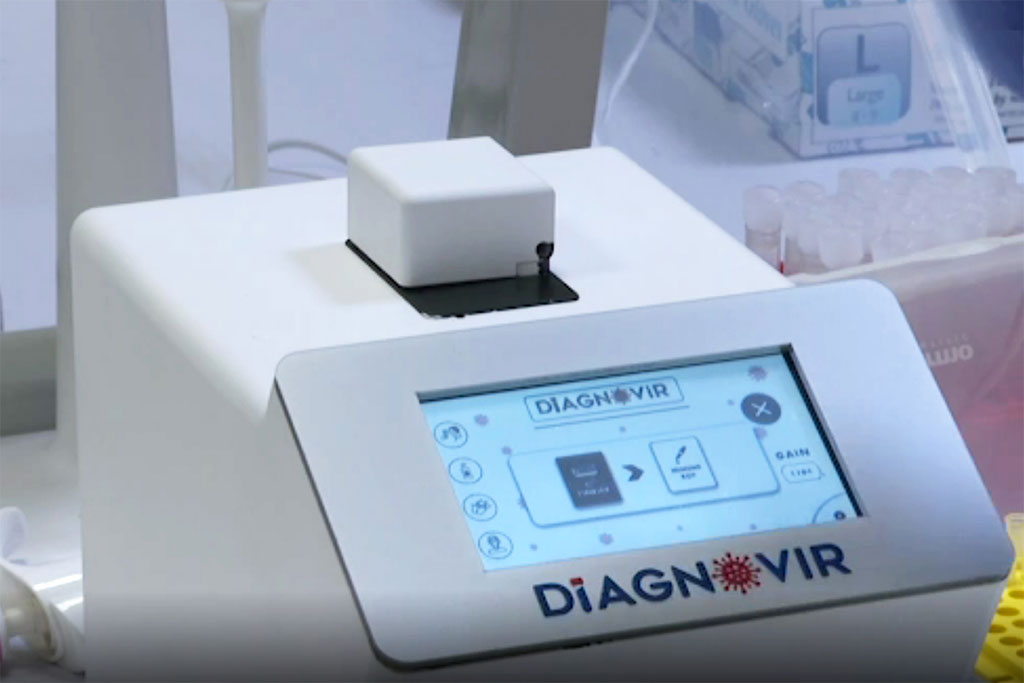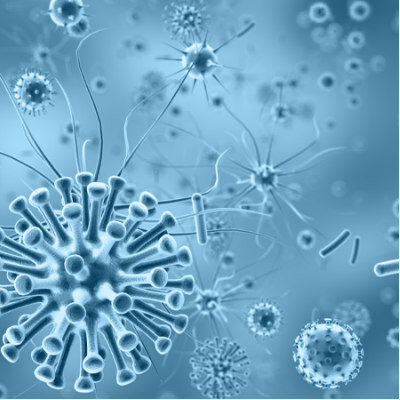New Nanotechnology-Based Diagnostic System Detects COVID-19 Within 10 Seconds
|
By LabMedica International staff writers Posted on 05 Jan 2021 |

Image: Diagnovir (Photo courtesy of Bilkent University)
A newly developed COVID-19 diagnostic system uses nanotechnology to provide results in 10 seconds with 99% accuracy.
A team of researchers from the Bilkent University (Ankara, Turkey) has developed an “in vitro” virus diagnosis system that can be used to detect the SARS-CoV-2 virus. The new nanotechnology-based diagnostic system, called Diagnovir, can detect the COVID-19 virus within 10 seconds with a swab taken from the mouth. It is an optically based diagnostic and identification system that changes the color of the glow in the presence of the virus, thus detecting viruses with high selectivity.
In this system, pathogens are detected within 10 seconds by dynamically receiving a fluorescent signal via a pathogen detection chip developed specifically for a biosensor device. After the sample is taken from the patient, it is mixed with a special solution, dropped on the pathogen detection chip, and if there is a pathogen in the environment by the biosensor device, the presence of pathogens with high accuracy is detected by taking the fluorescent signal.
Unlike the commonly used PCR tests, the system is not based on sample replication, but on detecting the presence or absence of the virus with advanced optical methods. In the system, optical and electronic modules that provide both precise virus detection and high selectivity in detection, as well as high-level biotechnology and material science knowledge are used. The system has shown 99% success in virus detection in pre-clinical studies conducted so far.
Related Links:
Bilkent University
A team of researchers from the Bilkent University (Ankara, Turkey) has developed an “in vitro” virus diagnosis system that can be used to detect the SARS-CoV-2 virus. The new nanotechnology-based diagnostic system, called Diagnovir, can detect the COVID-19 virus within 10 seconds with a swab taken from the mouth. It is an optically based diagnostic and identification system that changes the color of the glow in the presence of the virus, thus detecting viruses with high selectivity.
In this system, pathogens are detected within 10 seconds by dynamically receiving a fluorescent signal via a pathogen detection chip developed specifically for a biosensor device. After the sample is taken from the patient, it is mixed with a special solution, dropped on the pathogen detection chip, and if there is a pathogen in the environment by the biosensor device, the presence of pathogens with high accuracy is detected by taking the fluorescent signal.
Unlike the commonly used PCR tests, the system is not based on sample replication, but on detecting the presence or absence of the virus with advanced optical methods. In the system, optical and electronic modules that provide both precise virus detection and high selectivity in detection, as well as high-level biotechnology and material science knowledge are used. The system has shown 99% success in virus detection in pre-clinical studies conducted so far.
Related Links:
Bilkent University
Latest COVID-19 News
- New Immunosensor Paves Way to Rapid POC Testing for COVID-19 and Emerging Infectious Diseases
- Long COVID Etiologies Found in Acute Infection Blood Samples
- Novel Device Detects COVID-19 Antibodies in Five Minutes
- CRISPR-Powered COVID-19 Test Detects SARS-CoV-2 in 30 Minutes Using Gene Scissors
- Gut Microbiome Dysbiosis Linked to COVID-19
- Novel SARS CoV-2 Rapid Antigen Test Validated for Diagnostic Accuracy
- New COVID + Flu + R.S.V. Test to Help Prepare for `Tripledemic`
- AI Takes Guesswork Out Of Lateral Flow Testing
- Fastest Ever SARS-CoV-2 Antigen Test Designed for Non-Invasive COVID-19 Testing in Any Setting
- Rapid Antigen Tests Detect Omicron, Delta SARS-CoV-2 Variants
- Health Care Professionals Showed Increased Interest in POC Technologies During Pandemic, Finds Study
- Set Up Reserve Lab Capacity Now for Faster Response to Next Pandemic, Say Researchers
- Blood Test Performed During Initial Infection Predicts Long COVID Risk
- Low-Cost COVID-19 Testing Platform Combines Sensitivity of PCR and Speed of Antigen Tests
- Finger-Prick Blood Test Identifies Immunity to COVID-19
- Quick Test Kit Determines Immunity Against COVID-19 and Its Variants
Channels
Clinical Chemistry
view channel
Blood Test Could Predict and Identify Early Relapses in Myeloma Patients
Multiple myeloma is an incurable cancer of the bone marrow, and while many patients now live for more than a decade after diagnosis, a significant proportion relapse much earlier with poor outcomes.... Read more
Compact Raman Imaging System Detects Subtle Tumor Signals
Accurate cancer diagnosis often depends on labor-intensive tissue staining and expert pathological review, which can delay results and limit access to rapid screening. These conventional methods also make... Read moreMolecular Diagnostics
view channel
Sepsis Test Demonstrates Strong Performance in Post-Cardiac Surgery Patients
Sepsis is difficult to diagnose accurately in patients recovering from major surgery, as infection-related symptoms often overlap with non-infectious systemic inflammatory responses. This challenge is... Read more
Next-Gen Automated ELISA System Elevates Laboratory Performance
A next-generation automated ELISA system is designed to elevate laboratory performance through advanced workflow automation, enhanced connectivity, and a modernized user experience. DYNEX Technologies... Read more
At-Home Blood Tests Accurately Detect Key Alzheimer's Biomarkers
Diagnosing Alzheimer’s disease typically relies on brain scans or spinal fluid tests, which are invasive, costly, and difficult to access outside specialist clinics. These barriers have limited large-scale... Read more
Blood Test Combined with MRI Brain Scans Reveals Two Distinct Multiple Sclerosis Types
Multiple sclerosis (MS) affects more than 2.8 million people worldwide, yet predicting how the disease will progress in individual patients remains difficult. Current MS classifications are based on clinical... Read moreHematology
view channel
MRD Tests Could Predict Survival in Leukemia Patients
Acute myeloid leukemia is an aggressive blood cancer that disrupts normal blood cell production and often relapses even after intensive treatment. Clinicians currently lack early, reliable markers to predict... Read more
Platelet Activity Blood Test in Middle Age Could Identify Early Alzheimer’s Risk
Early detection of Alzheimer’s disease remains one of the biggest unmet needs in neurology, particularly because the biological changes underlying the disorder begin decades before memory symptoms appear.... Read more
Microvesicles Measurement Could Detect Vascular Injury in Sickle Cell Disease Patients
Assessing disease severity in sickle cell disease (SCD) remains challenging, especially when trying to predict hemolysis, vascular injury, and risk of complications such as vaso-occlusive crises.... Read more
ADLM’s New Coagulation Testing Guidance to Improve Care for Patients on Blood Thinners
Direct oral anticoagulants (DOACs) are one of the most common types of blood thinners. Patients take them to prevent a host of complications that could arise from blood clotting, including stroke, deep... Read moreImmunology
view channel
Ultrasensitive Liquid Biopsy Demonstrates Efficacy in Predicting Immunotherapy Response
Immunotherapy has transformed cancer treatment, but only a small proportion of patients experience lasting benefit, with response rates often remaining between 10% and 20%. Clinicians currently lack reliable... Read more
Blood Test Could Identify Colon Cancer Patients to Benefit from NSAIDs
Colon cancer remains a major cause of cancer-related illness, with many patients facing relapse even after surgery and chemotherapy. Up to 40% of people with stage III disease experience recurrence, highlighting... Read moreMicrobiology
view channel
New UTI Diagnosis Method Delivers Antibiotic Resistance Results 24 Hours Earlier
Urinary tract infections affect around 152 million people every year, making them one of the most common bacterial infections worldwide. In routine medical practice, diagnosis often relies on rapid urine... Read more
Breakthroughs in Microbial Analysis to Enhance Disease Prediction
Microorganisms shape human health, ecosystems, and the planet’s climate, yet identifying them and understanding how they are related remains a major scientific challenge. Even with modern DNA sequencing,... Read morePathology
view channel
ADLM Updates Expert Guidance on Urine Drug Testing for Patients in Emergency Departments
Urine drug testing plays a critical role in the emergency department, particularly for patients presenting with suspected overdose or altered mental status. Accurate and timely results can directly influence... Read more
New Age-Based Blood Test Thresholds to Catch Ovarian Cancer Earlier
Ovarian cancer affects around one in 50 women during their lifetime, with roughly 7,000 diagnoses each year in the UK. The disease is often detected late because symptoms such as bloating, abdominal pain,... Read moreTechnology
view channel
Pioneering Blood Test Detects Lung Cancer Using Infrared Imaging
Detecting cancer early and tracking how it responds to treatment remains a major challenge, particularly when cancer cells are present in extremely low numbers in the bloodstream. Circulating tumor cells... Read more
AI Predicts Colorectal Cancer Survival Using Clinical and Molecular Features
Colorectal cancer is one of the most common and deadly cancers worldwide, and accurately predicting patient survival remains a major clinical challenge. Traditional prognostic tools often rely on either... Read moreIndustry
view channel
BD and Penn Institute Collaborate to Advance Immunotherapy through Flow Cytometry
BD (Becton, Dickinson and Company, Franklin Lakes, NJ, USA) has entered into a strategic collaboration with the Institute for Immunology and Immune Health (I3H, Philadelphia, PA, USA) at the University... Read more






















